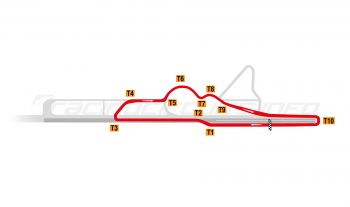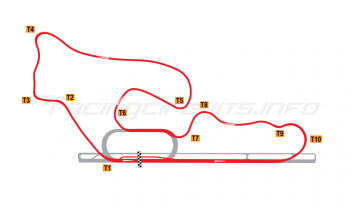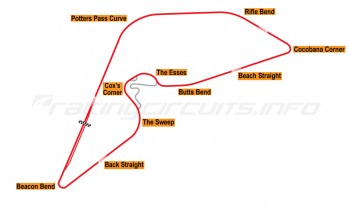Chicago Street Circuit
Circuit Overview
Life imitated art when NASCAR hosted its first race on the streets of Chicago, a year on from the circuit featuring in virtual form as part of the eNASCAR iRacing Pro Invitational Series.
Designed by iRacing itself, the course takes in some of the city’s most iconic landmarks, such as Grant Park and the Buckingham Fountain, close to the waterfront of Monroe Bay and Soldier Field stadium, home to the Chicago Bears.
Despite rain disrupting the weekend schedule, the event was nonetheless deemed a success, with a notable victory on his NASCAR debut for visiting Australian Supercars champion Shane van Gisbergen.
Circuit History
NASCAR has been on something of a mission in recent years to spice up the show and bring its form of entertainment to new fans. An expansion of road course racing has followed, along with more innovative changes, such as the Bristol Dirt Race and the Busch Clash at LA Memorial Coliseum. Street racing, therefore, was perhaps the next logical extension.
Discussions had been taking place with the Chicago authorities for a number of years, with the area around Green Park identified as a home for a street race. That decision brought echoes of a decades earlier attempt to organise a Chicago street race; in September 1980, a Chicago Grand Prix was announced as part of the following year’s CART Indycar championship, with the event to take place on Independence Day, with a Can-Am race the following day.
The then Mayor Jane Byrne called it “an excellent way to showcase our city to the rest of the world.” Sadly, opposition soon mounted to the course, which was set to measure 2.7 miles and feature 11 turns. Opponents branded it a distraction from more important problems facing Chicago, such a crime and poverty. Disruption to major traffic routes were also cited and after just 44 days the event had been canned.
Fast forward 40 years and that opposition had faded, to the point that city authorities were once again ready to embrace the idea of racing. With NASCAR keen to establish a new home in Chicago, closer to the downtown area than its own Chicagoland Speedway, the idea was once again revived.
A virtual start becomes a reality
Perhaps unusually, NASCAR took the decision to employ iRacing to identify the layout of the circuit, using their expertise to create a virtual circuit, albeit with the intention of also creating the real thing in due course.
During the autumn of 2020, iRacing staff headed to downtown Chicago to scan the city streets with the goal of devising a viable racetrack. From these efforts, a recommendation of which streets would prove most suitable was put forward and a green light was given to produce the circuit in virtual form. Data from iRacing online sessions featuring the track and numerous races with drivers from the eNASCAR Coca-Cola iRacing Series, the premier NASCAR esports series on iRacing, helped to hone the project.
The layout was then approved and unveiled for an eNASCAR iRacing Pro Invitational Series event that was televised live in June 2021. Fast forward to the next month and the announcement that the virtual circuit was going to become a reality in 2023, marking the first time the premier series had been seen on a street course.

“Seeing NASCAR on the streets of Chicago become a reality is a major accomplishment, and iRacing is thrilled to have played a part,” said iRacing executive vice president Steve Myers. “In recent years, the leading brands in motorsports have relied on iRacing to not only simulate their existing products, but also to experiment with new car and track concepts. Taking the NASCAR Cup Series to the streets for the first time in Chicago is a direct result of our work together, and we’re looking forward to seeing the concept come to life!”
The 2.14-mile, 12-turn circuit that was released to all iRacing members features many of the city’s iconic landmarks in the backdrop, including Grant Park and the Buckingham Fountain.
NASCAR arrives to wet weekend
The debut event weekend was set for early July 2023, with the Chicago race replacing Road America on the Cup Series schedule. A NASCAR Xfinity race was also included on the schedule, with concerts from The Black Crowes, The Chainsmokers and Miranda Lambert on Lakefront Green adding to the entertainments.
Saturday's Xfinity race thus had the honour of being the first NASCAR-sanctioned street race, though the weather gods intervened to ensure that it was a much shortened affair. Cole Custer led all 25 laps before lightning strikes in the area caused NASCAR to red flag the race and then to postpone completion until Sunday morning. But the rain persisted, leaving officials with little choice but to declare the race three laps short of halfway and five laps short of the completion of Stage 2. Stewart-Haas Ford driver Custer was thus the track's first winner.
Explaining the decision, NASCAR said: “With standing water and flooding a significant issue at the race track and throughout the city, there was no option to return to racing prior to shifting to NASCAR Cup Series race operations. Throughout the entire planning process for the Chicago Street Race, our relationship with the City of Chicago has been strong and among the most valuable assets in reaching this historic weekend.
“In the spirit of that partnership, returning on Monday for the completion of a NASCAR Xfinity Series event two laps short of halfway was an option we chose not to employ. Based on several unprecedented circumstances, NASCAR has made the decision to declare Cole Custer the winner of the race.”
Rookie sweeps all before him
The Sunday rain caused the Cup Series race to start an hour behind schedule, with the track still very wet though eventually drying out. NASCAR’s decision near the midpoint of the event to shorten the race from the scheduled 100 laps to 75, put a large group of cars that had pitted on Lap 43 inside their fuel window. Among them was Kiwi driver and Australian Supercars champion Shane van Gisbergen, competing in his first NASCAR race as part of Trackhouse Racing’s Project 91 program. He moved his way up through the field from 18th all the way to the lead. Despite a late caution causing an overtime finish, the rookie driver held on take the first Cup Series win on the streets. It was the first debut race win since Johnny Rutherford in 1963.
Afterwards there was much positivity about the race and track from the drivers. Xfinity racer Justin Allgaier, who grew up in Illinois, summed up his experience: “The view is incredible — of all the racetracks I’ve ever been at, this is by far the coolest views. It’s so wild. It’s almost surreal.
“Coming here as a kid, never did I think this was a possibility.”
Cup Series driver Chase Briscoe was slightly more measured: “Truthfully, for a street course, I think it raced better than I thought it would. There are definitely parts that can be improved like widening the track and other certain things. But, all things considered, it surprised me compared to what I thought it was going to be. I thought there were a ton of fans here, and I thought the event was cool.
"I would have loved for the weather to cooperate, so we could have seen what this event could’ve really turned into. Because, there were still so many people out there for how bad the weather was. Hopefully, we can do it again, do a couple things better, and put on an even better race.”
It seems likely he will get his wish granted, with the track website already announcing a waitlist for 2024 tickets.
Jump onboard
Plan a visit
Get your race tickets!
Brought to you with: 
We've teamed up with Motorsports Tickets to bring you the best deals for Formula One, MotoGP, Le Mans and more.










